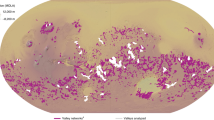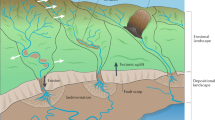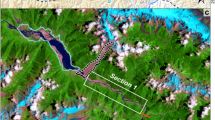Abstract
One of the most striking examples of self-organization in landscapes is the emergence of evenly spaced ridges and valleys1,2,3,4,5,6. Despite the prevalence of uniform valley spacing, no theory has been shown to predict this fundamental topographic wavelength. Models of long-term landscape evolution can produce landforms that look realistic7,8,9, but few metrics exist to assess the similarity between models and natural landscapes. Here we show that the ridge–valley wavelength can be predicted from erosional mechanics. From equations of mass conservation and sediment transport, we derive a characteristic length scale at which the timescales for erosion by diffusive soil creep and advective stream incision are equal. This length scale is directly proportional to the valley spacing that emerges in a numerical model of landform evolution, and to the measured valley spacing at five field sites. Our results provide a quantitative explanation for one of the most widely observed characteristics of landscapes. The findings also imply that valley spacing is a fundamental topographic signature that records how material properties and climate regulate erosional processes.
This is a preview of subscription content, access via your institution
Access options
Subscribe to this journal
Receive 51 print issues and online access
$199.00 per year
only $3.90 per issue
Buy this article
- Purchase on Springer Link
- Instant access to full article PDF
Prices may be subject to local taxes which are calculated during checkout



Similar content being viewed by others
References
Shaler, N. S. Spacing of rivers with reference to the hypothesis of base-levelling. Geol. Soc. Am. Bull. 10, 263–276 (1899)
Izumi, N. & Parker, G. Inception of channelization and drainage basin formation: upstream-driven theory. J. Fluid Mech. 283, 341–363 (1995)
Hovius, N. Regular spacing of drainage outlets from linear mountain belts. Basin Res. 8, 29–44 (1996)
Talling, P. J., Stewart, M. D., Stark, C. P., Gupta, S. & Vincent, S. J. Regular spacing of drainage outlets from linear fault blocks. Basin Res. 9, 275–302 (1997)
Izumi, N. & Parker, G. Linear stability analysis of channel inception: downstream-driven theory. J. Fluid Mech. 419, 239–262 (2000)
Perron, J. T., Kirchner, J. W. & Dietrich, W. E. Spectral signatures of characteristic spatial scales and non-fractal structure in landscapes. J. Geophys. Res. 113 F04003 10.1029/2007JF000866 (2008)
Willgoose, G., Bras, R. L. & Rodriguez-Iturbe, I. Results from a new model of river basin evolution. Earth Surf. Process. Landf. 16, 237–254 (1991)
Howard, A. D. A detachment-limited model of drainage basin evolution. Wat. Resour. Res. 30, 2261–2286 (1994)
Tucker, G. E. & Bras, R. L. Hillslope processes, drainage density, and landscape morphology. Wat. Resour. Res. 34, 2751–2764 (1998)
Gilbert, G. K. Report on the Geology of the Henry Mountains 99–150 (US Government Printing Office, 1877)
Davis, W. M. The convex profile of badland divides. Science 20, 245 (1892)
Gilbert, G. K. The convexity of hilltops. J. Geol. 17, 344–350 (1909)
Smith, T. R. & Bretherton, F. P. Stability and the conservation of mass in drainage basin evolution. Wat. Resour. Res. 8, 1506–1529 (1972)
Loewenherz, D. S. Stability and the initiation of channelized surface drainage: a reassessment of the short wavelength limit. J. Geophys. Res. 96, 8453–8464 (1991)
Simpson, G. & Schlunegger, F. Topographic evolution and morphology of surfaces evolving in response to coupled fluvial and hillslope sediment transport. J. Geophys. Res. 108 2300 10.1029/2002JB002162 (2003)
Dunne, T. Formation and controls of channel networks. Prog. Phys. Geogr. 4, 211–239 (1980)
Kirkby, M. J. in Geomorphological Models: Theoretical and Empirical Aspects (ed. F. Ahnert) 1–14 (Catena, 1987)
Willgoose, G., Bras, R. L. & Rodriguez-Iturbe, I. A physical explanation of an observed link area-slope relationship. Wat. Resour. Res. 27, 1697–1702 (1991)
Tarboton, D. G., Bras, R. L. & Rodriguez-Iturbe, I. A physical basis for drainage density. Geomorphology 5, 59–76 (1992)
Howard, A. D. Badland morphology and evolution: Interpretation using a simulation model. Earth Surf. Process. Landf. 22, 211–227 (1997)
Moglen, G. E., Eltahir, E. A. B. & Bras, R. L. On the sensitivity of drainage density to climate change. Wat. Resour. Res. 34, 855–862 (1998)
Horton, R. E. Erosional development of streams and their drainage basins: hydrophysical approach to quantitative morphology. Bull. Geol. Soc. Am. 56, 275–370 (1945)
Perron, J. T., Dietrich, W. E. & Kirchner, J. W. Controls on the spacing of first-order valleys. J. Geophys. Res. 113 F04016 10.1029/2007JF000977 (2008)
Hilley, G. E. & Arrowsmith, J. R. Geomorphic response to uplift along the Dragon's Back pressure ridge, Carrizo Plain, California. Geology 36, 367–370 (2008)
Fernandes, N. F. & Dietrich, W. E. Hillslope evolution by diffusive processes: the timescale for equilibrium adjustments. Wat. Resour. Res. 33, 1307–1318 (1997)
Prosser, I. P. & Dietrich, W. E. Field experiments on erosion by overland flow and their implication for a digital terrain model of channel initiation. Wat. Resour. Res. 31, 2867–2876 (1995)
Montgomery, D. R. & Dietrich, W. E. Where do channels begin? Nature 336, 232–234 (1988)
Montgomery, D. R. & Dietrich, W. E. Channel initiation and the problem of landscape scale. Science 255, 826–830 (1992)
Rinaldo, A., Dietrich, W. E., Rigon, R., Vogel, G. K. & Rodriguez-Iturbe, I. Geomorphological signatures of varying climate. Nature 374, 632–635 (1995)
Seidl, M. A. & Dietrich, W. E. in Functional Geomorphology (eds K. H. Schmidt & J. de Ploey) 101–124 (Catena, 1992)
Acknowledgements
This work was supported by the National Science Foundation (J.T.P.), the Institute for Geophysics and Planetary Physics (J.W.K. and J.T.P.), and NASA (W.E.D. and J.T.P.). Laser altimetry for Gabilan Mesa was acquired and processed by NCALM (http://www.ncalm.org) with support from the National Center for Earth-surface Dynamics (NCED). We thank the Orradre family of San Ardo, California, for granting access to their land. We thank the states of Pennsylvania and Utah for making laser altimetry data publicly available. We also thank K. Whipple for his review.
Author information
Authors and Affiliations
Corresponding author
Supplementary information
Supplementary Information
This file contains Supplementary Methods, Supplementary Figures S1-S3 with Legends, Supplementary Table S1 and Supplementary References. (PDF 1107 kb)
Supplementary Movie 1
This movie shows the evolution of the model landscape over 600 kyr. Competition for drainage area (a proxy for water flux) among the irregularly spaced, incipient valleys that arise in the random initial surface eventually leads to an equilibrium landscape with evenly spaced valleys. Horizontal tick interval is 200 m, vertical tick interval is 20 m. (MP4 2177 kb)
Rights and permissions
About this article
Cite this article
Perron, J., Kirchner, J. & Dietrich, W. Formation of evenly spaced ridges and valleys. Nature 460, 502–505 (2009). https://doi.org/10.1038/nature08174
Received:
Accepted:
Issue Date:
DOI: https://doi.org/10.1038/nature08174
This article is cited by
-
Past rainfall-driven erosion on the Chinese loess plateau inferred from archaeological evidence from Wucheng City, Shanxi
Communications Earth & Environment (2023)
-
Vegetation controls on channel network complexity in coastal wetlands
Nature Communications (2023)
-
A novel approach to the classification of terrestrial drainage networks based on deep learning and preliminary results on solar system bodies
Scientific Reports (2021)
-
The perpetual fragility of creeping hillslopes
Nature Communications (2021)
-
Numerical simulation of landscape evolution and mountain uplift history constrain—A case study from the youthful stage mountains around the central Hexi Corridor, NE Tibetan Plateau
Science China Earth Sciences (2021)
Comments
By submitting a comment you agree to abide by our Terms and Community Guidelines. If you find something abusive or that does not comply with our terms or guidelines please flag it as inappropriate.



